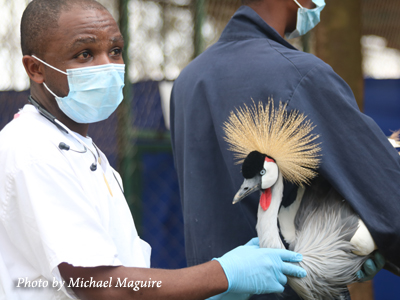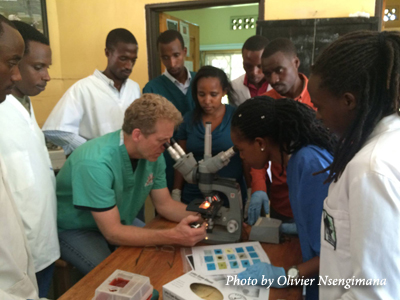
Grey Crowned Cranes are endangered for a host of reasons, ranging from habitat loss to power line collisions and poisonings. In Rwanda, where there are less than 500 remaining in the wild, the main threat is live trade. Cranes are taken out of marshes as eggs or chicks, and sold to wealthy individuals or businesses because they are believed to be symbols of good fortune. The people who keep cranes in captivity, usually unaware of the cranes’ protected status, often cut their feathers, or worse, break their wings to prevent escape. In 2014, Rwandan veterinarian Olivier Nsengimana, a Rolex Young Laureate award winner, began a groundbreaking public awareness and amnesty campaign to tackle the problem (click here to learn more about Olivier’s pioneering work). His extensive public outreach program, supported by the Rwandan government, has led to voluntary registrations of illegally held Grey Crowned Cranes, with the plan to surrender cranes for restoration to the wild.
To date, more than 190 captive cranes have been registered and removed from mostly sub-standard conditions. Each registered bird is evaluated for its potential to be safely reintroduced into the wild. The goal is to repatriate birds at Akagera National Park in eastern Rwanda and to bolster wild crane populations there. Of course, reintroduction of these fragile cranes is gradual, as most have little experience as free-ranging birds. The prolonged reintroduction occurs in close proximity to park headquarters where protection is provided and threats from predators are minimal. Most birds molt their damaged feathers during that time and re-grow healthy ones, while exercising their previously little-used flight muscles. The well-trained team is doing extraordinary work to return as many birds as possible to the wild.

In December, I was honored to travel to Rwanda to lend equipment and assistance to this effort. Upon arrival, I led a workshop on crane medicine and avian laboratory diagnostic techniques for 16 young Rwandan veterinarians and biologists at the Gorilla Doctors headquarters near Volcanoes National Park. I spent the remaining days of my visit assisting Dr. Nsengimana’s team at the quarantine facility in Kigali to evaluate the health of 36 confiscated cranes. Some of the problems were significant, such as wing and leg fractures, both old and new, along with complications from damaged feather follicles, likely caused by the pulling of feathers, and foot problems stemming from walking on hard surfaces while in captivity.
The next phase of the project is inspirational, as it focuses on the cranes left behind due to their poor prospects for a successful life in the wild. The International Crane Foundation is working with Dr. Nsengimana, who is proposing a sanctuary where many of the non-releasable cranes will be viewed by the public to raise awareness and support for crane conservation measures throughout Rwanda, and may provide offspring for re-stocking depleted wild populations. The sanctuary will also tackle the difficult problem of illegal trade and promote the health and resiliency of wild populations. On behalf of the International Crane Foundation, I want to extend my deepest gratitude to the dedicated team of veterinarians and volunteers who are working to protect the endangered Grey Crowned Cranes of Rwanda, as well as to Suzanne Hall Johnson for her generous support of conservation medicine at the International Crane Foundation.
 Story submitted by Dr. Barry Hartup, Director of Conservation Medicine for the International Crane Foundation. Learn more about our Global Headquarters programs and work in Sub/Saharan Africa.
Story submitted by Dr. Barry Hartup, Director of Conservation Medicine for the International Crane Foundation. Learn more about our Global Headquarters programs and work in Sub/Saharan Africa.
